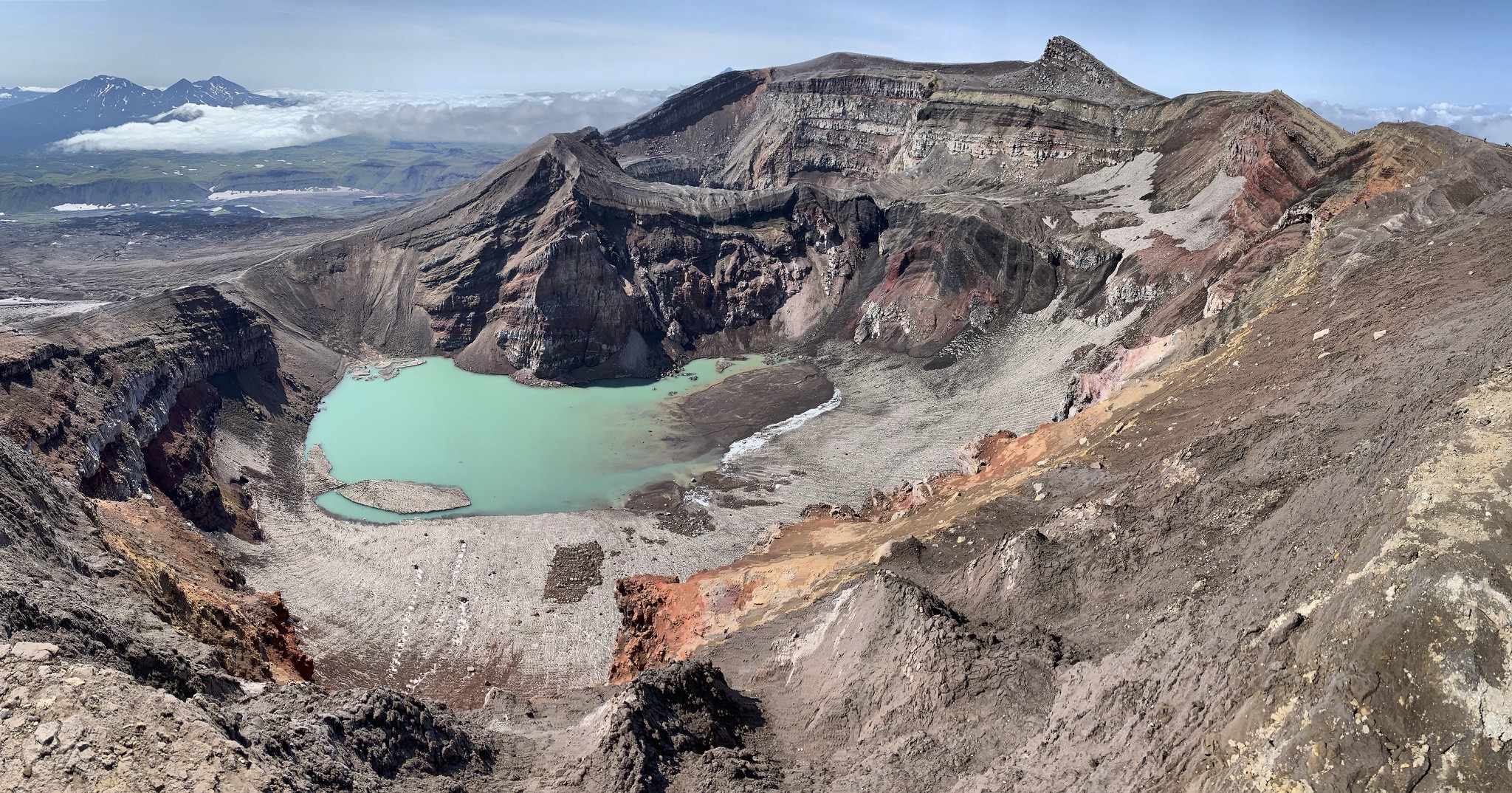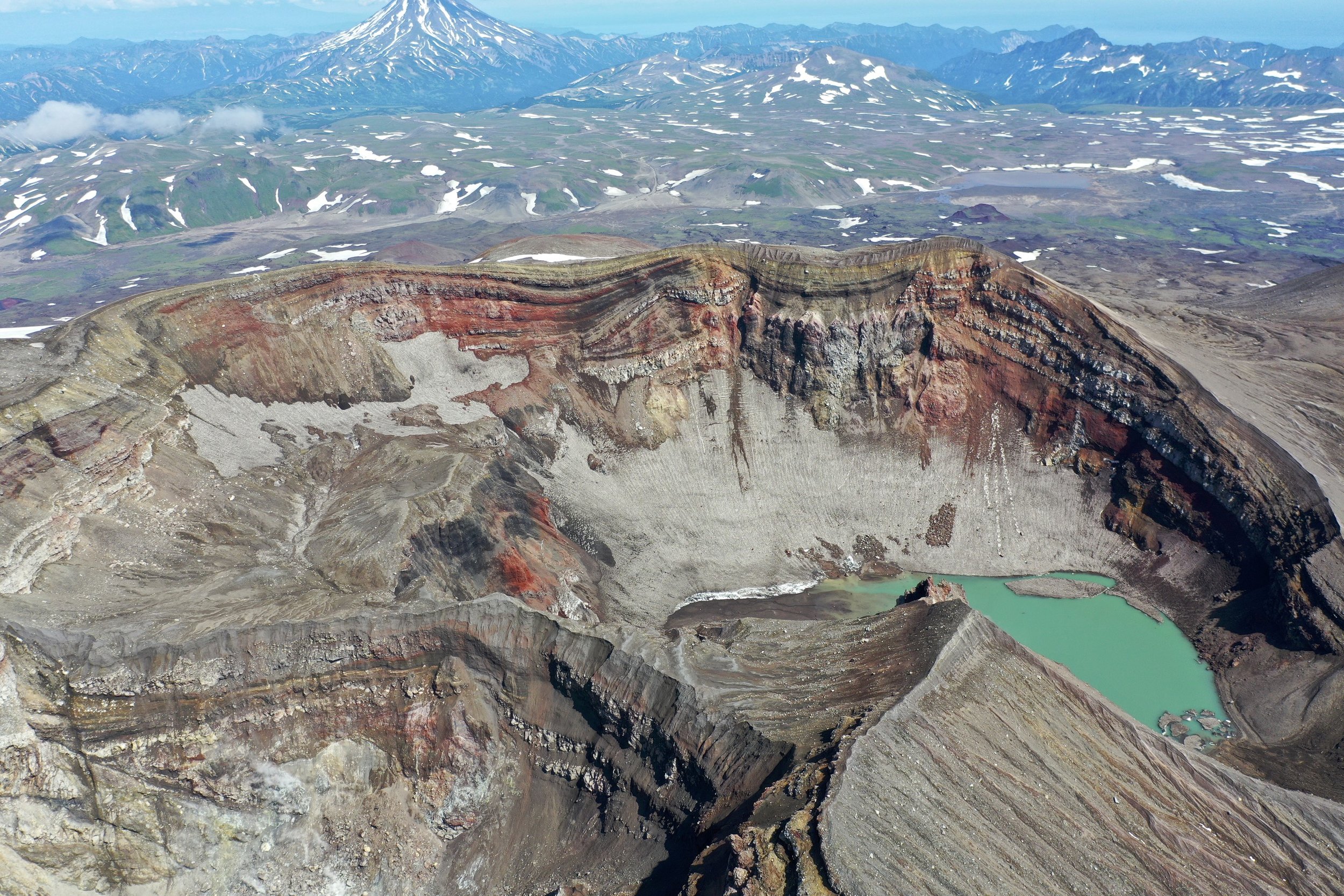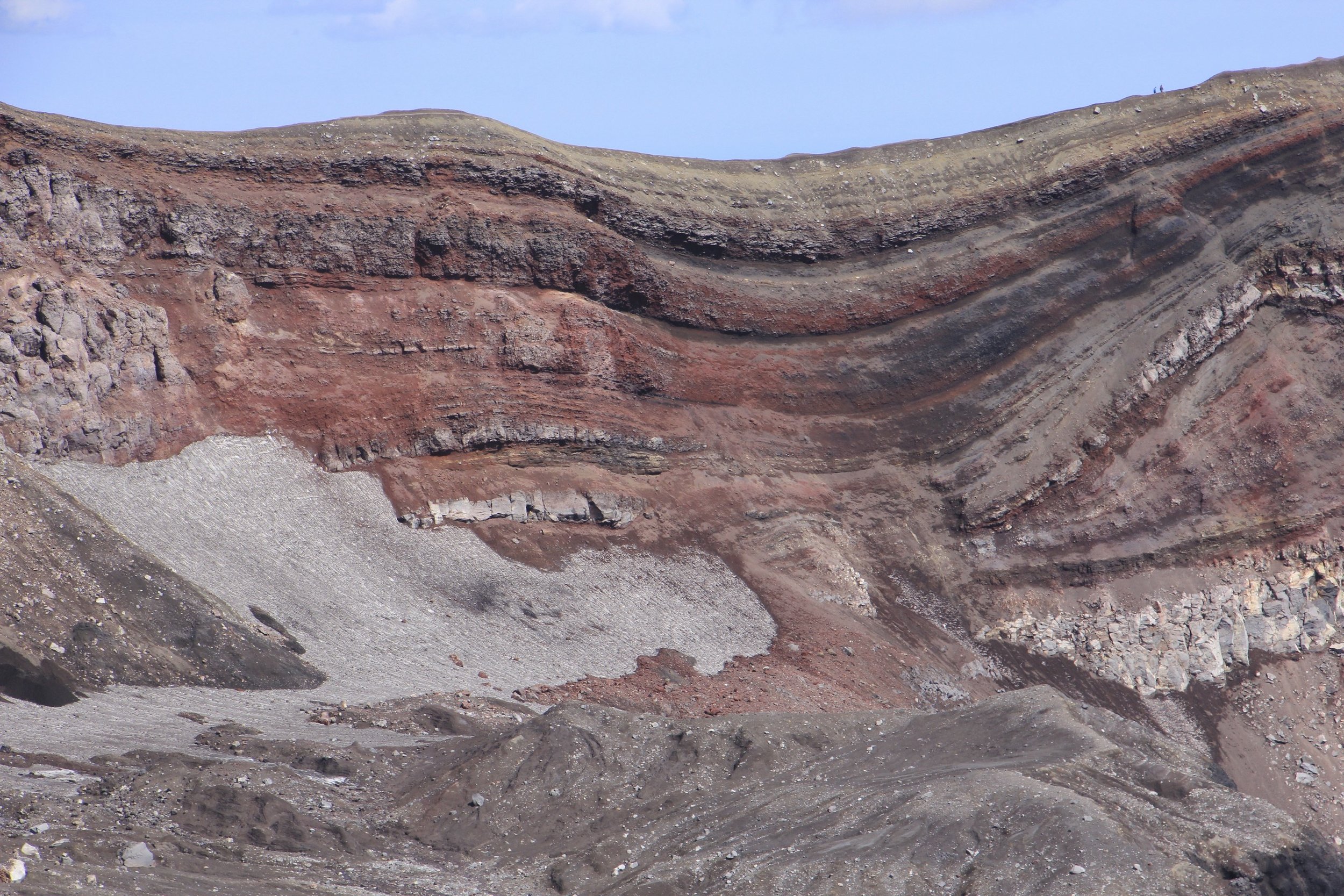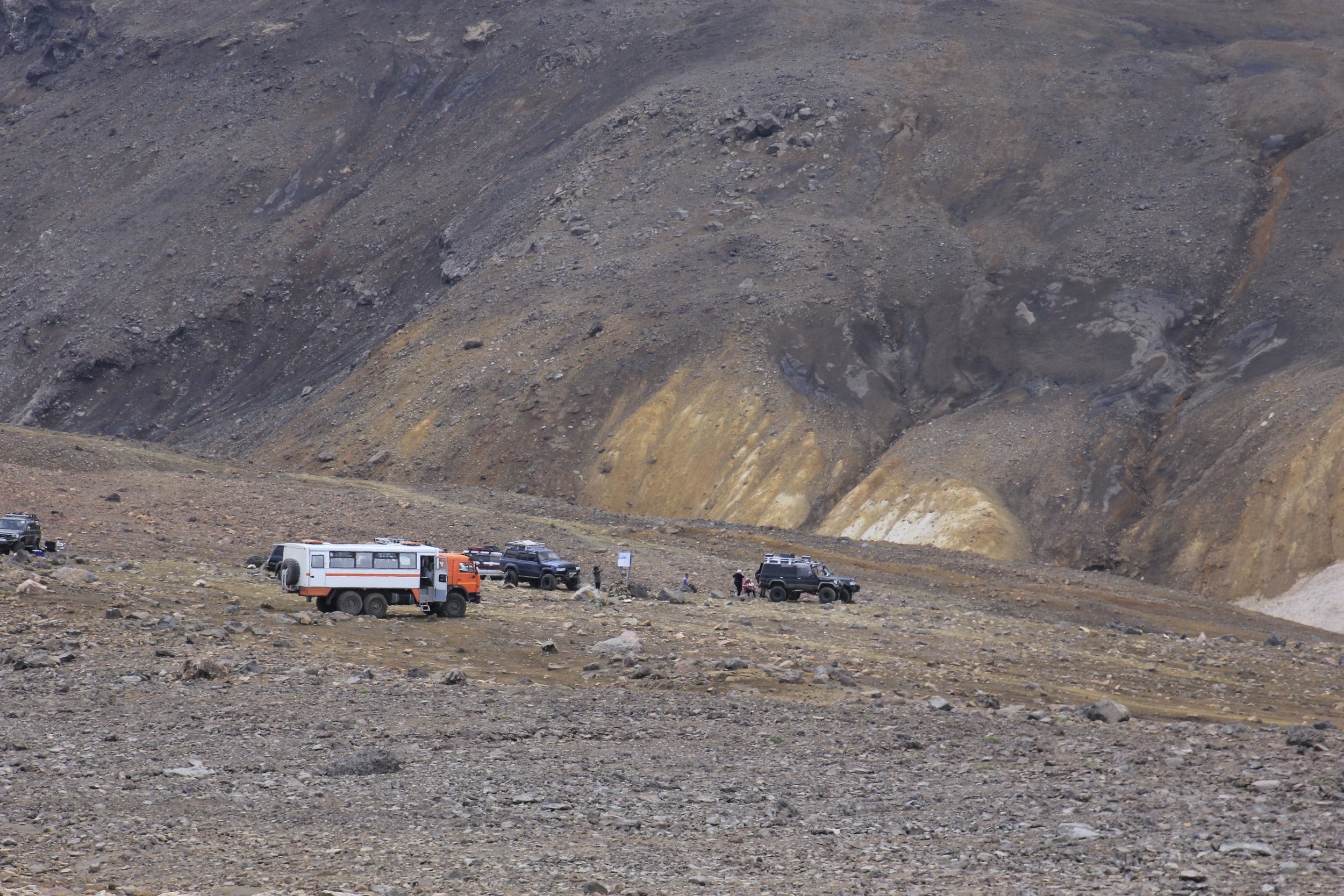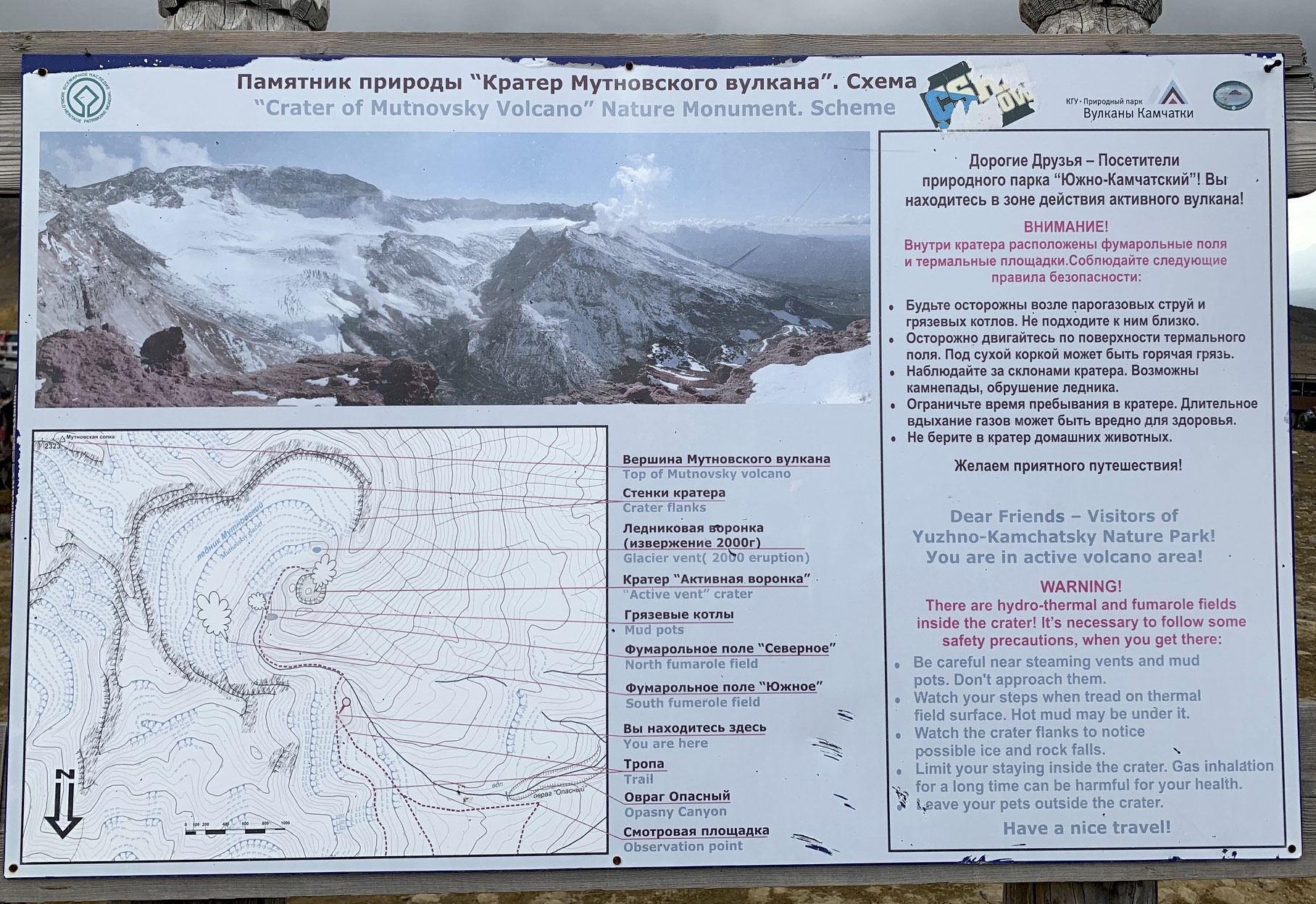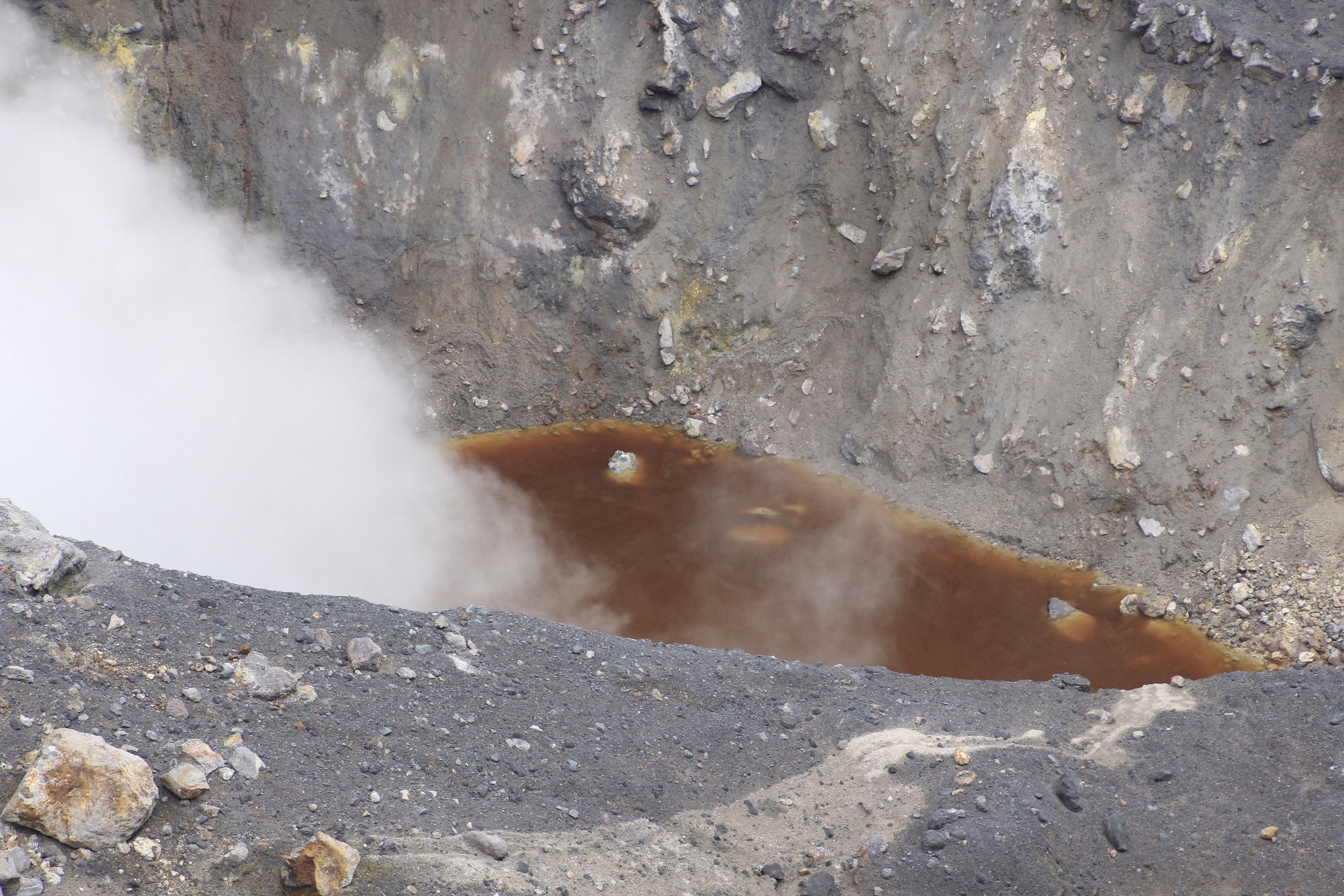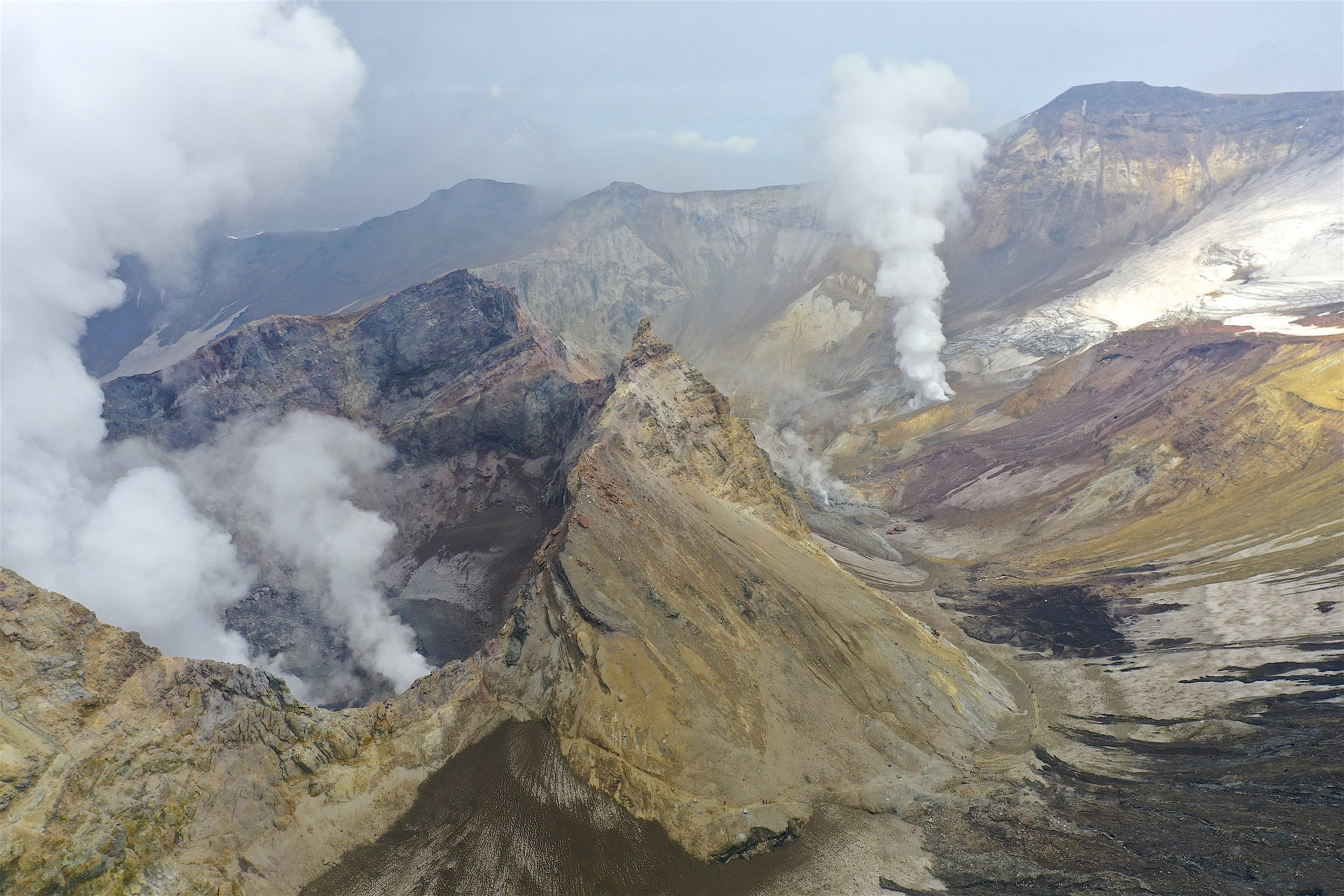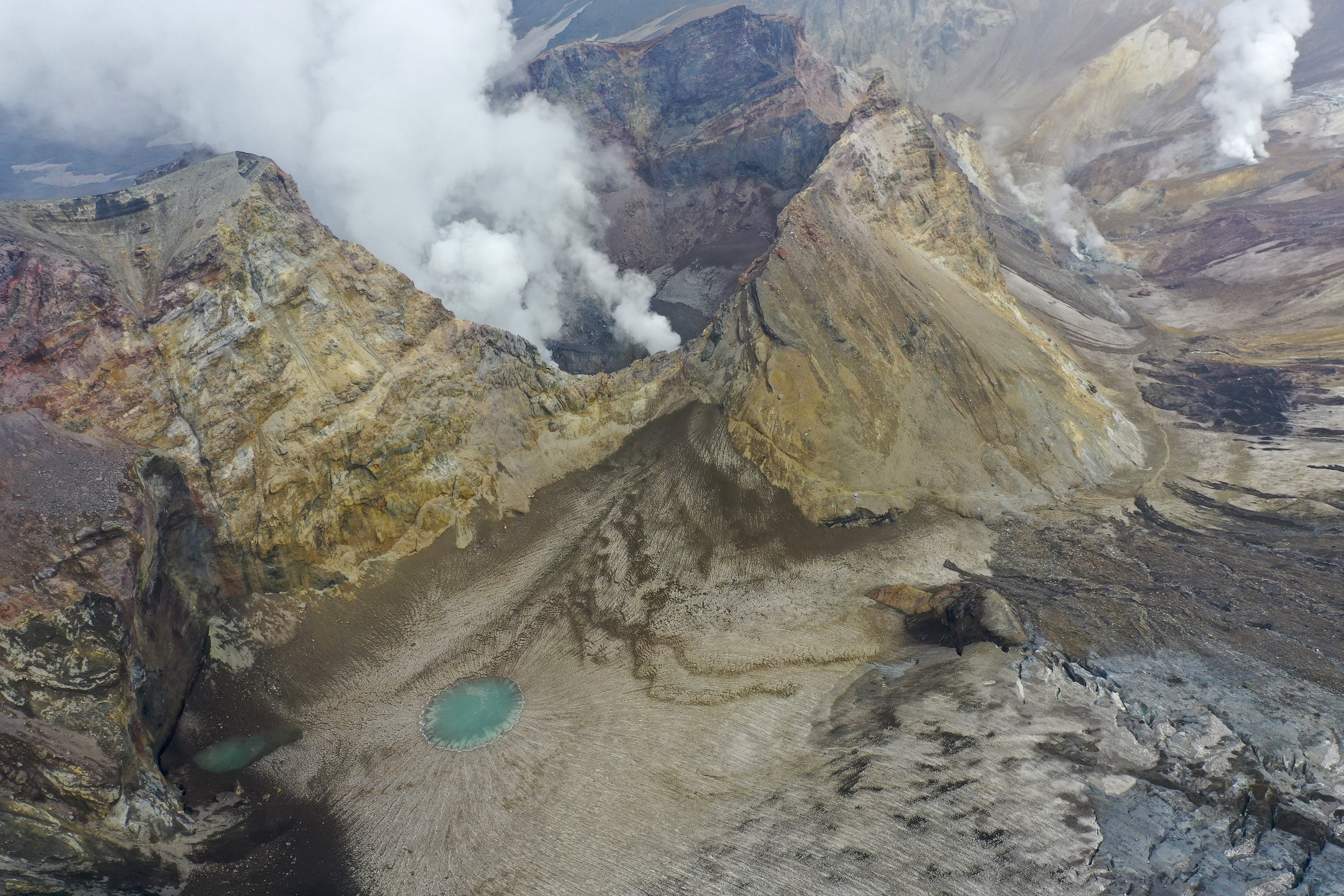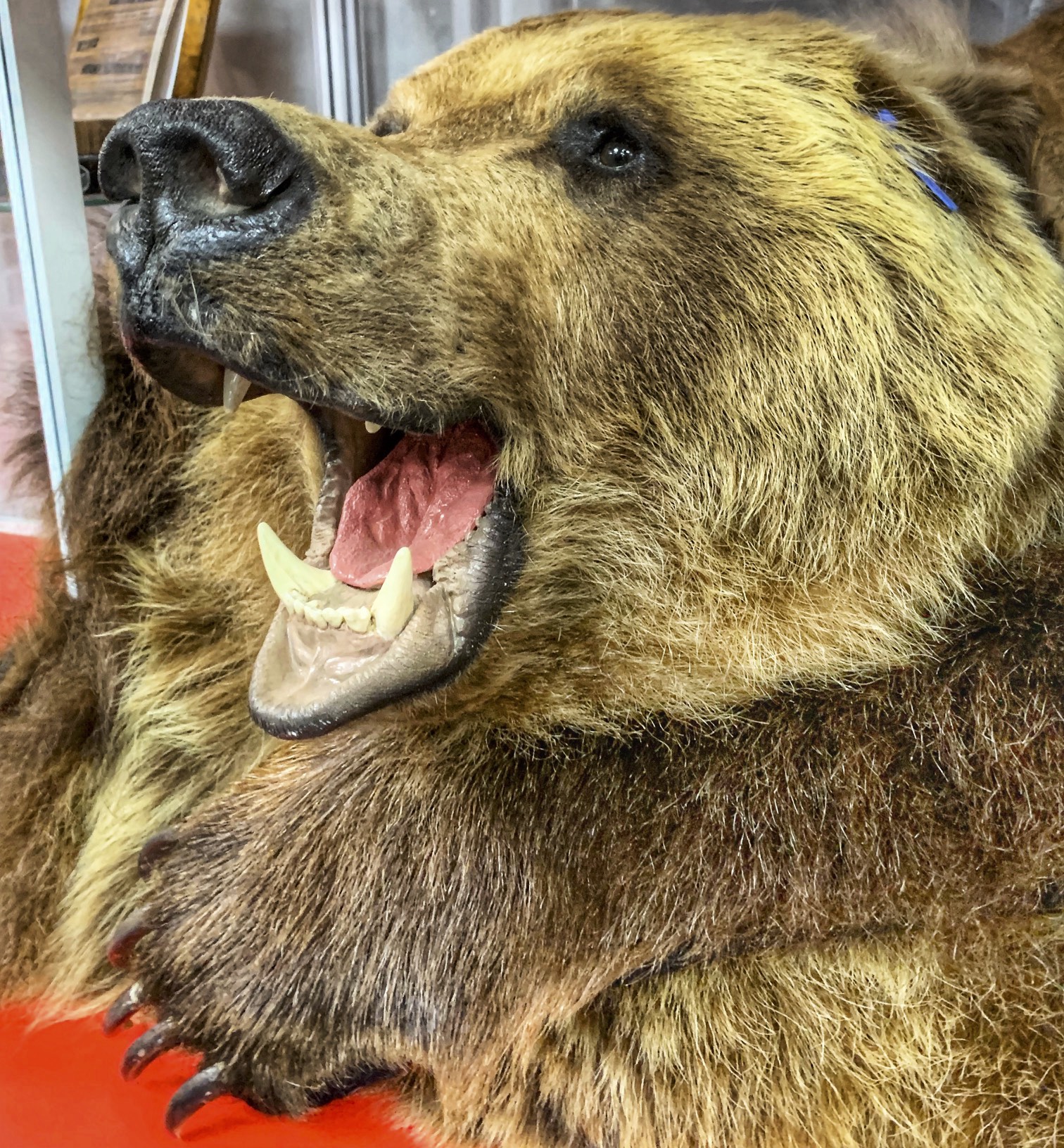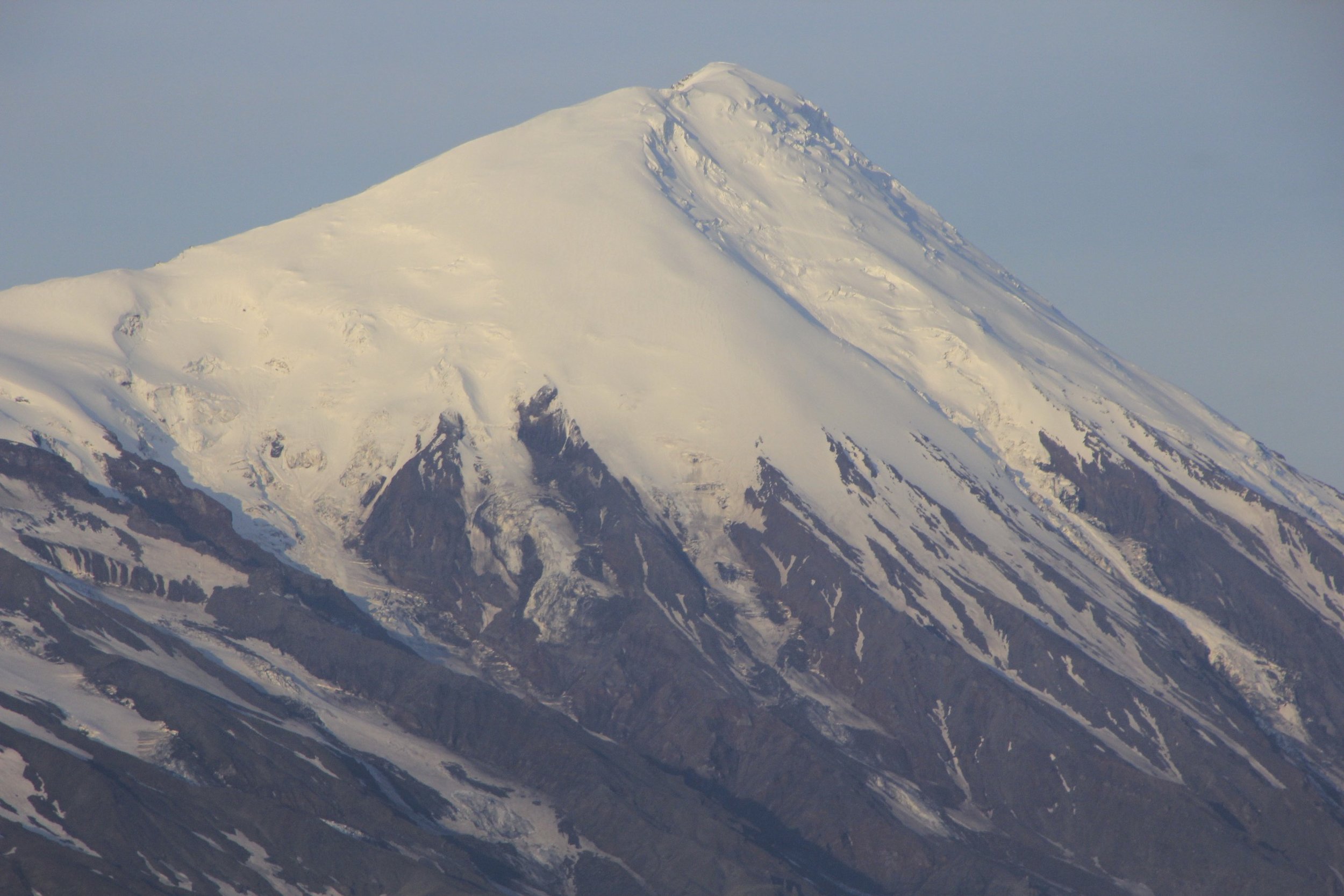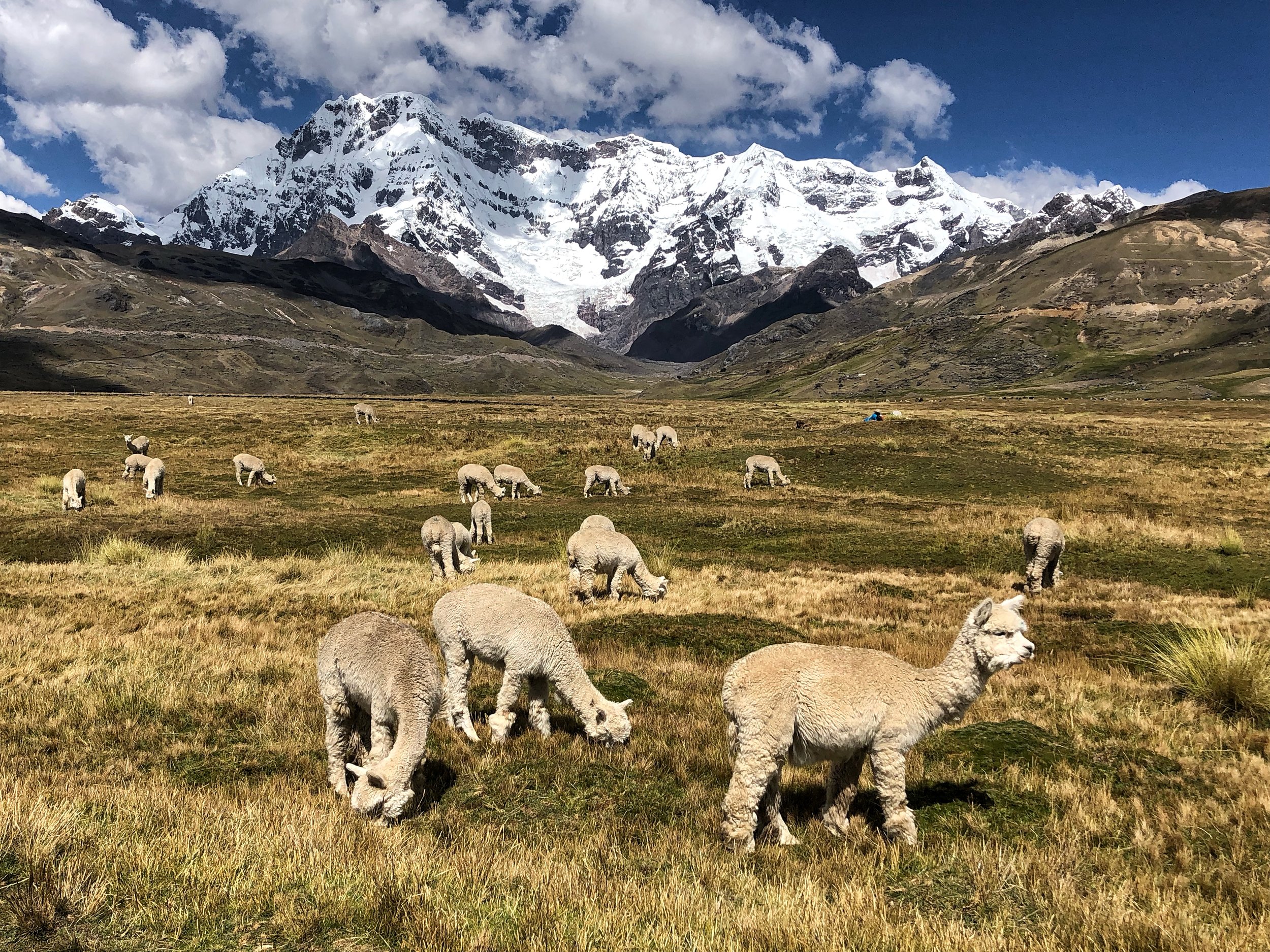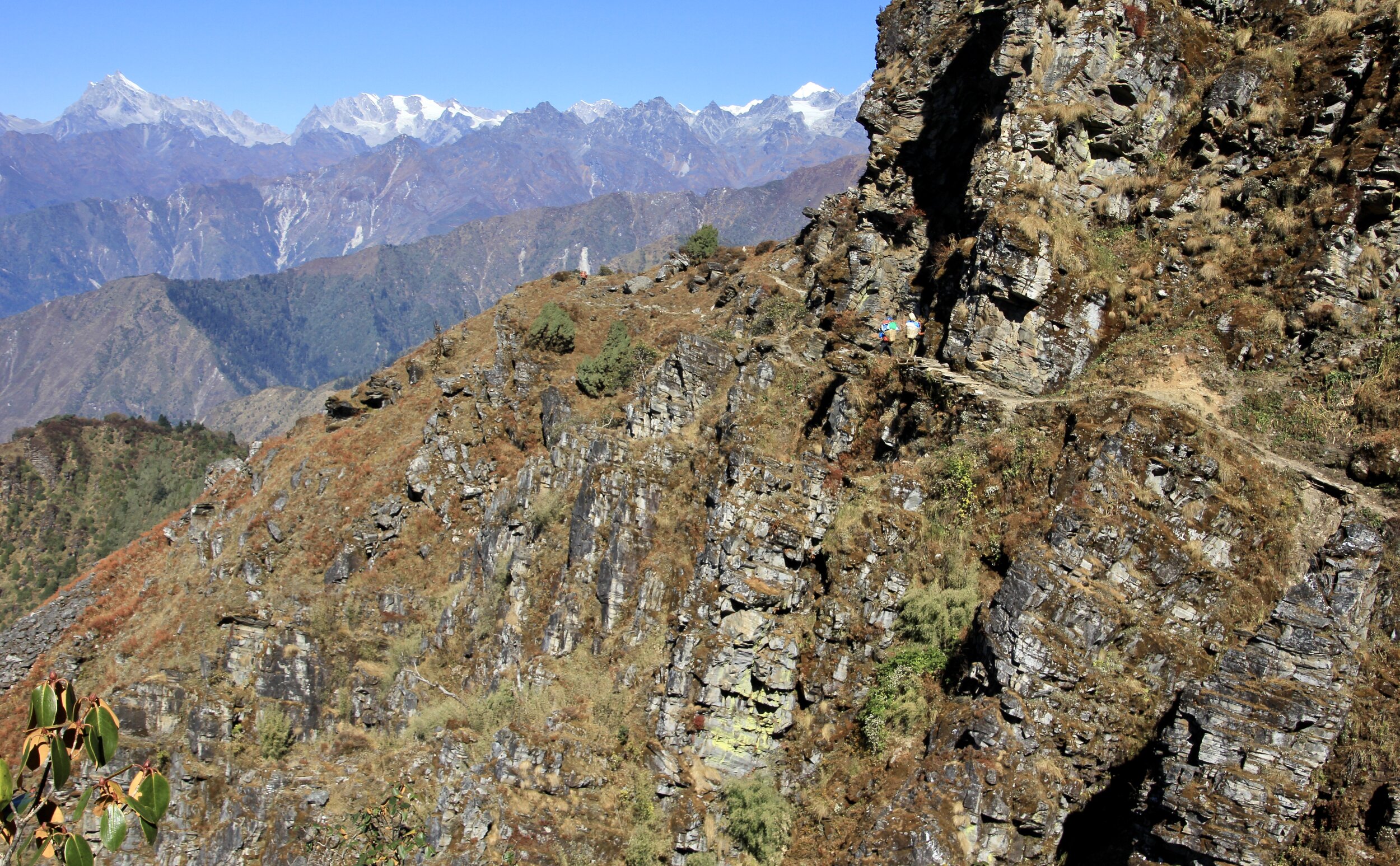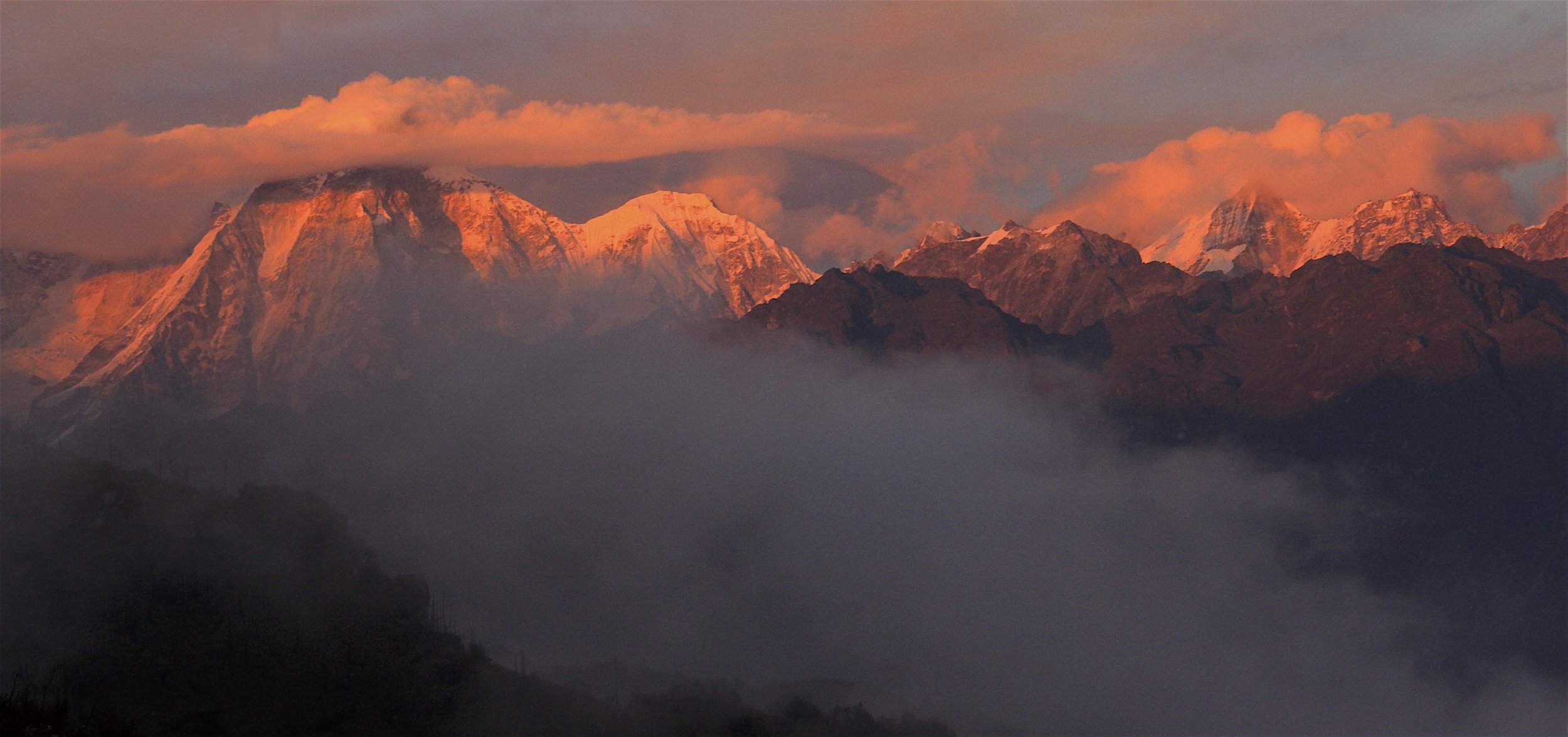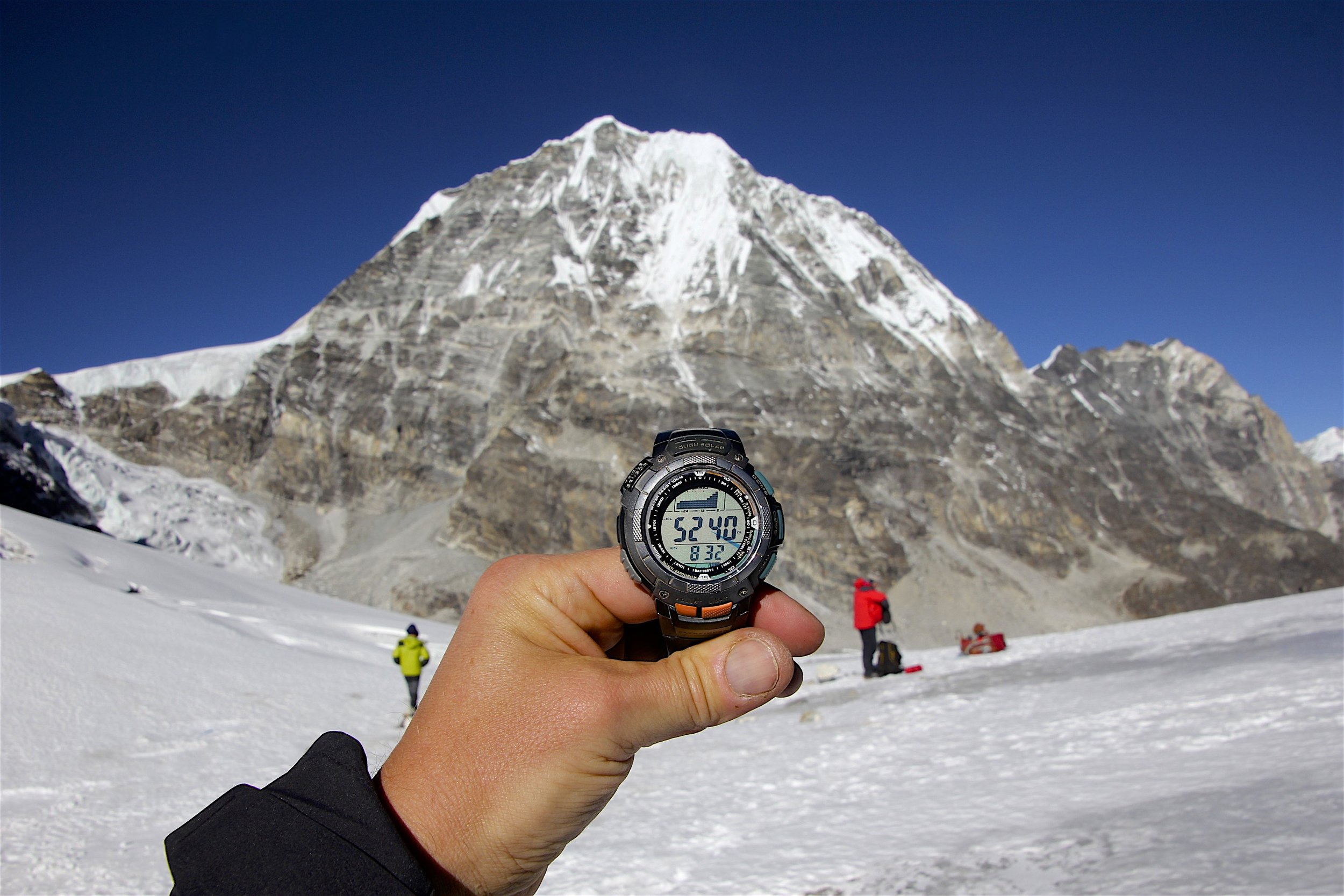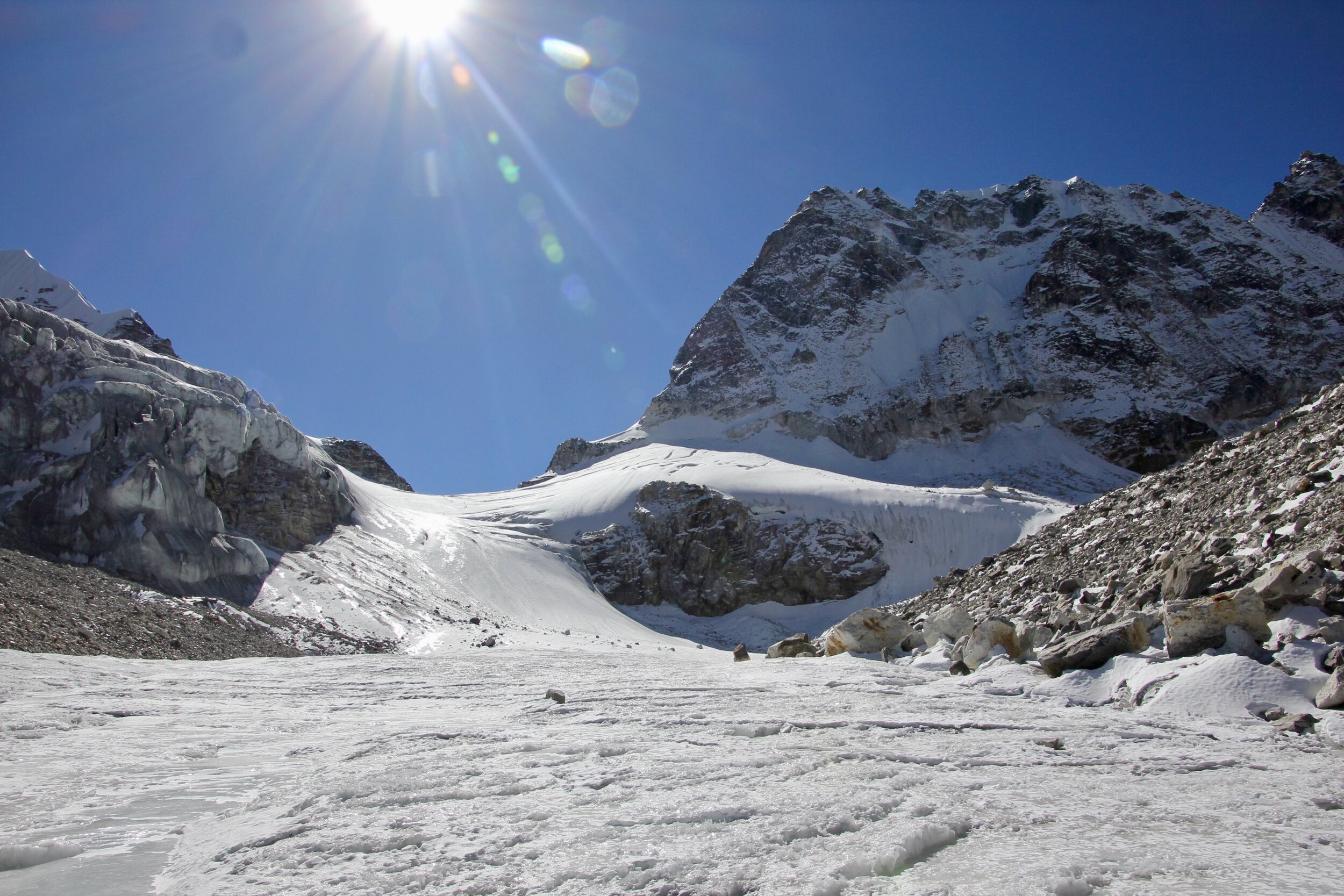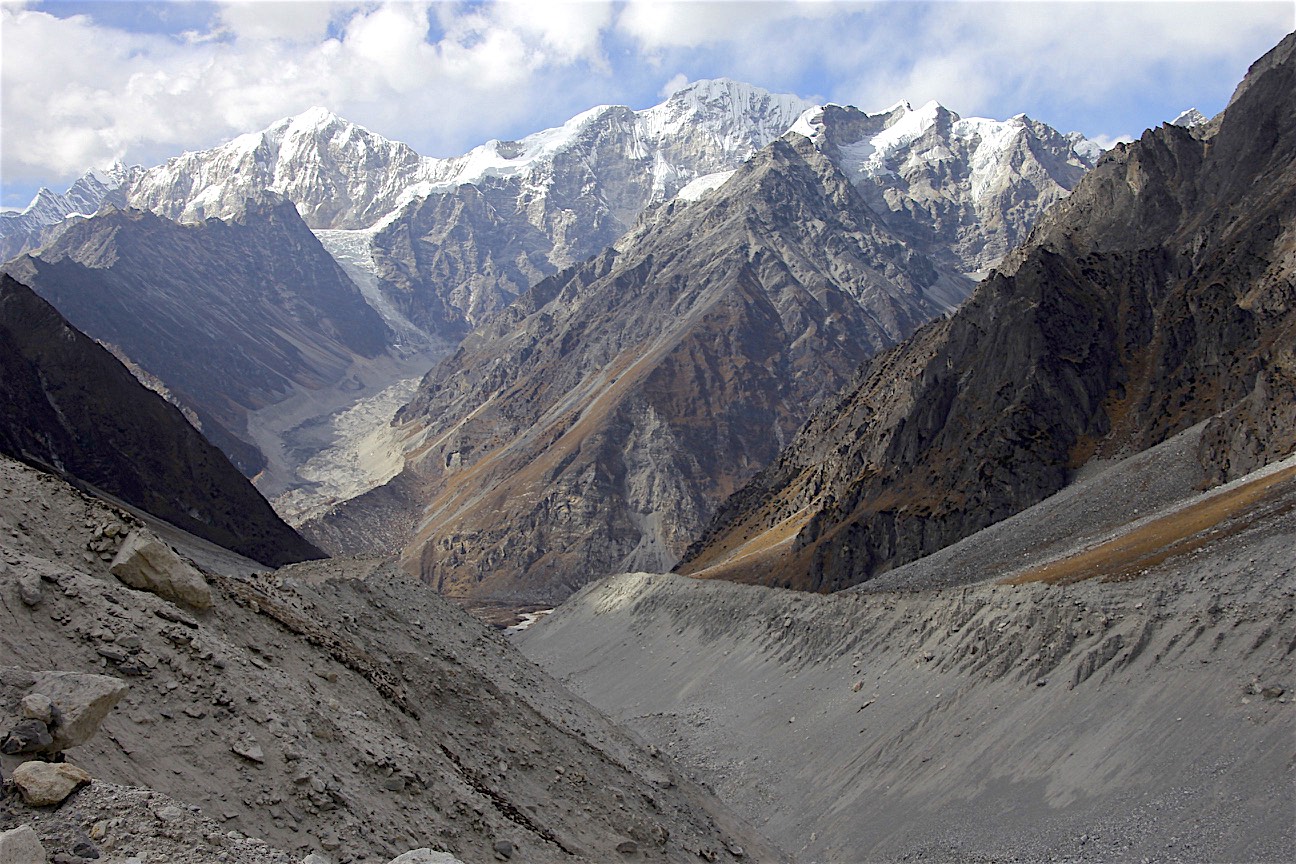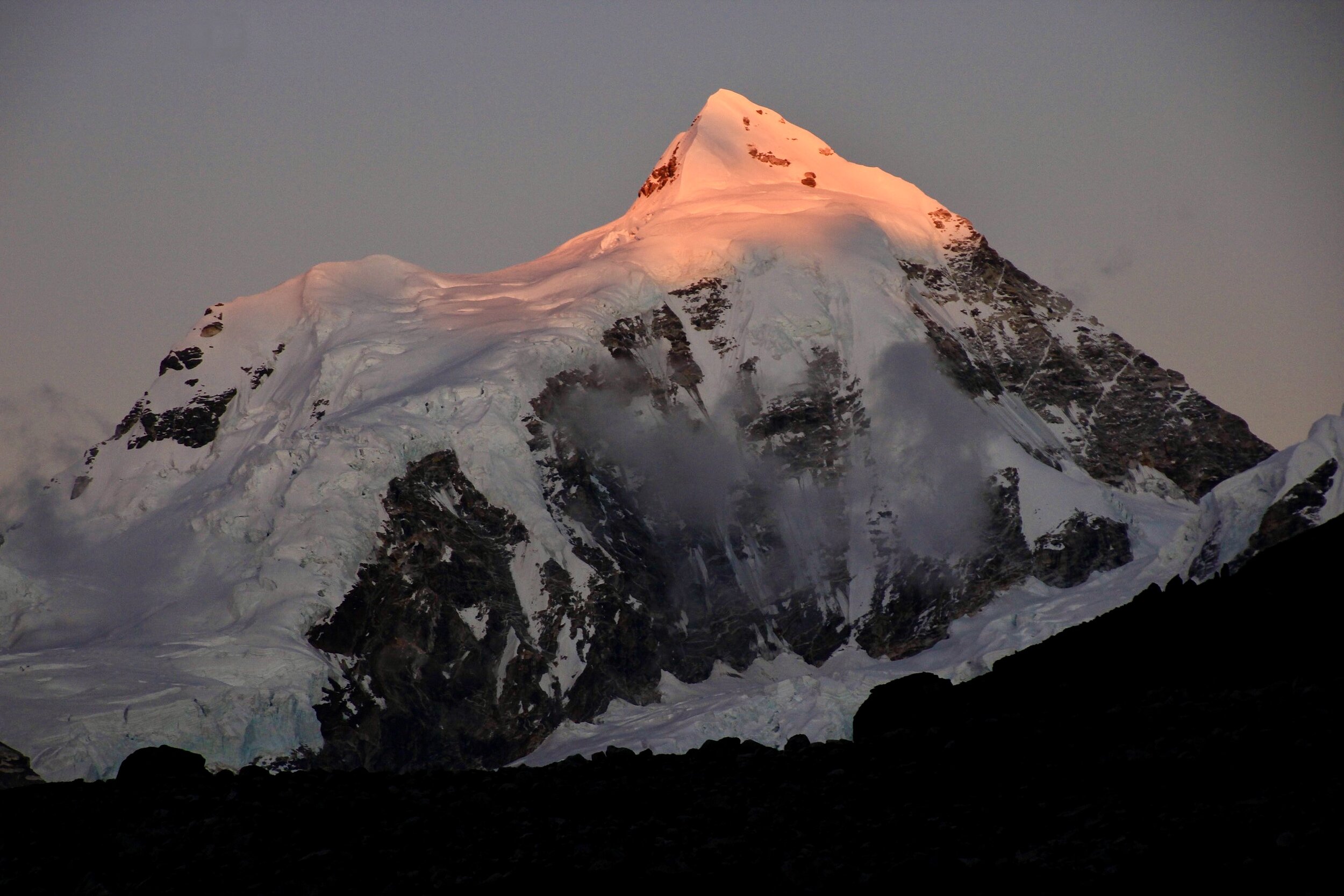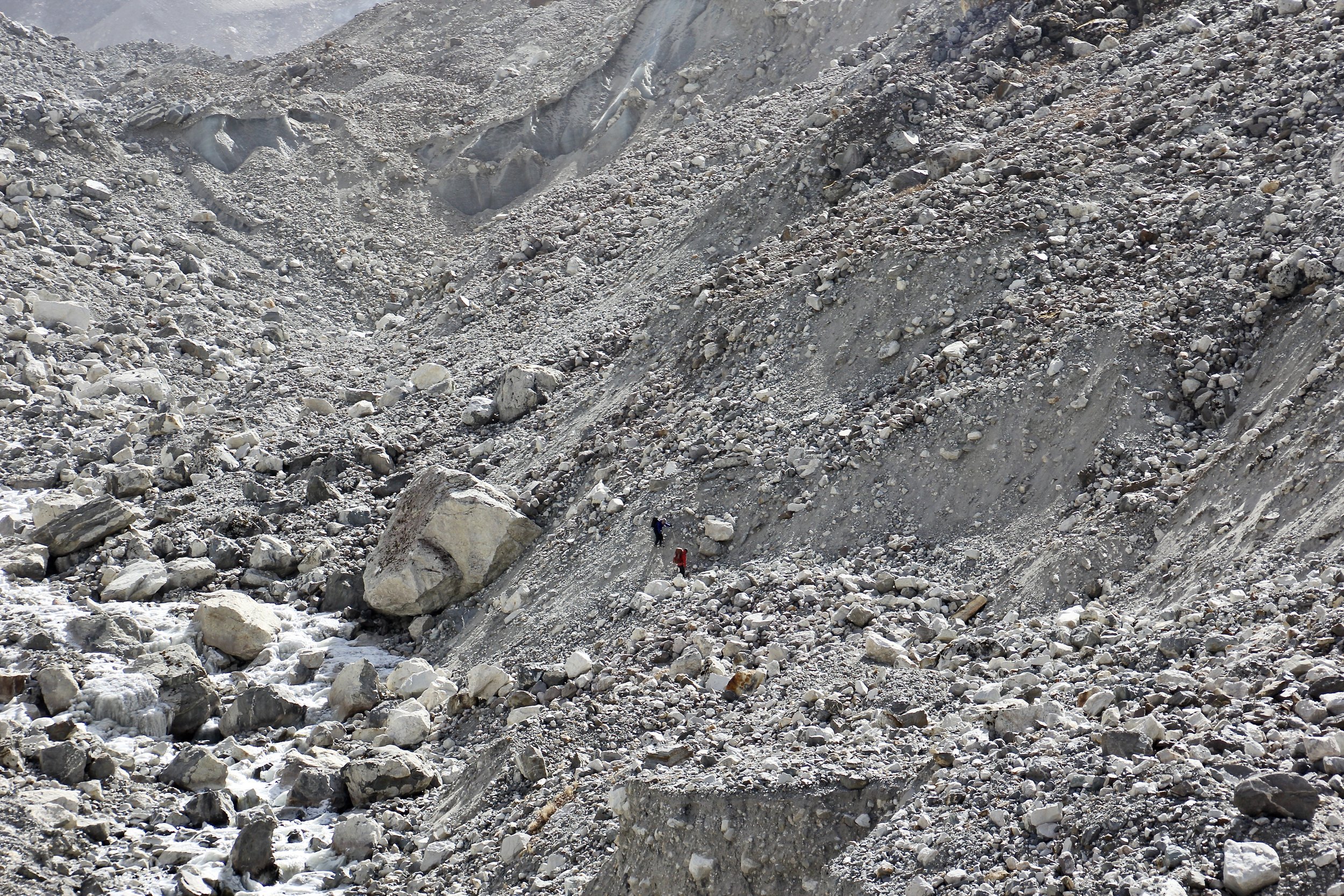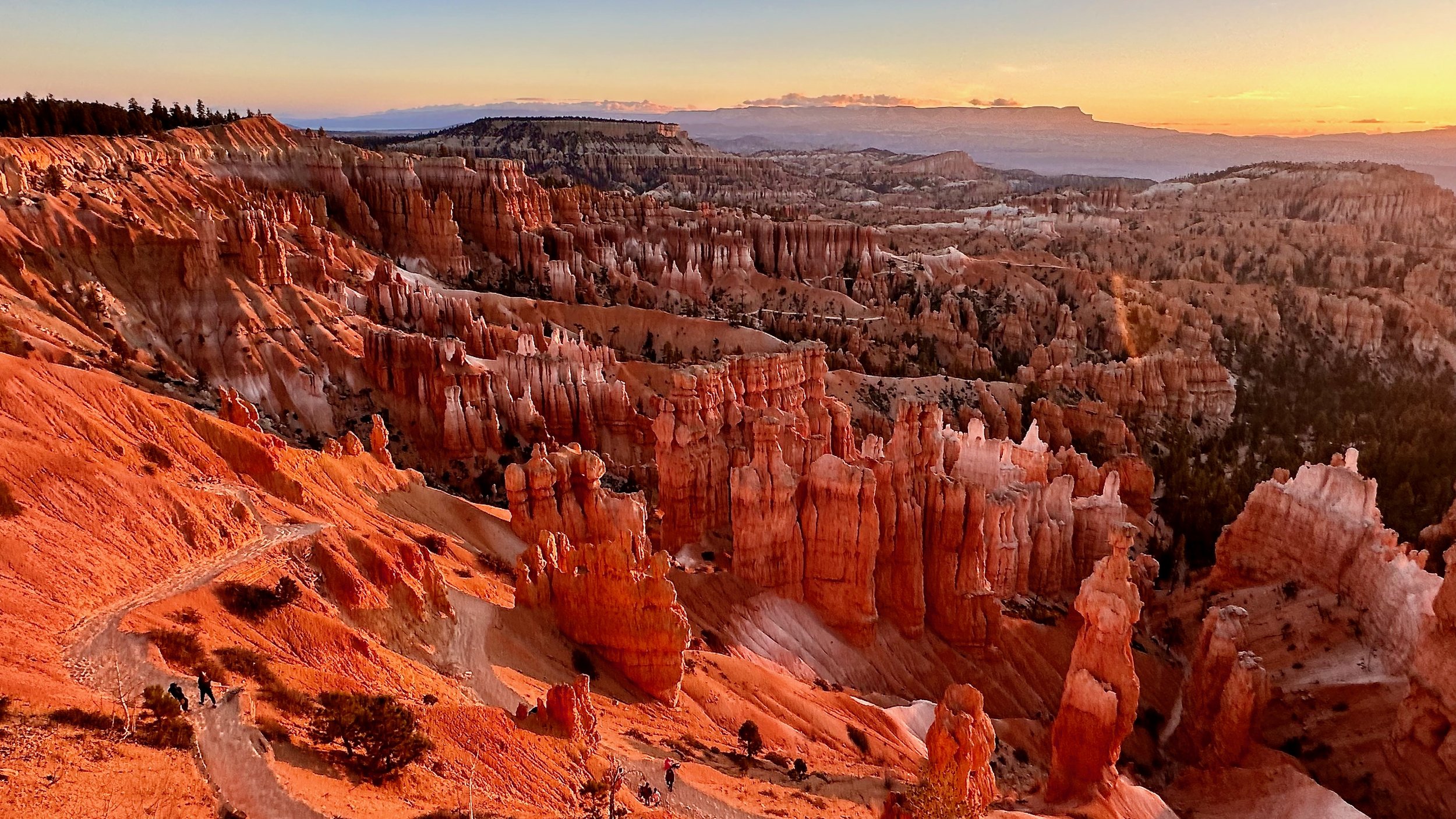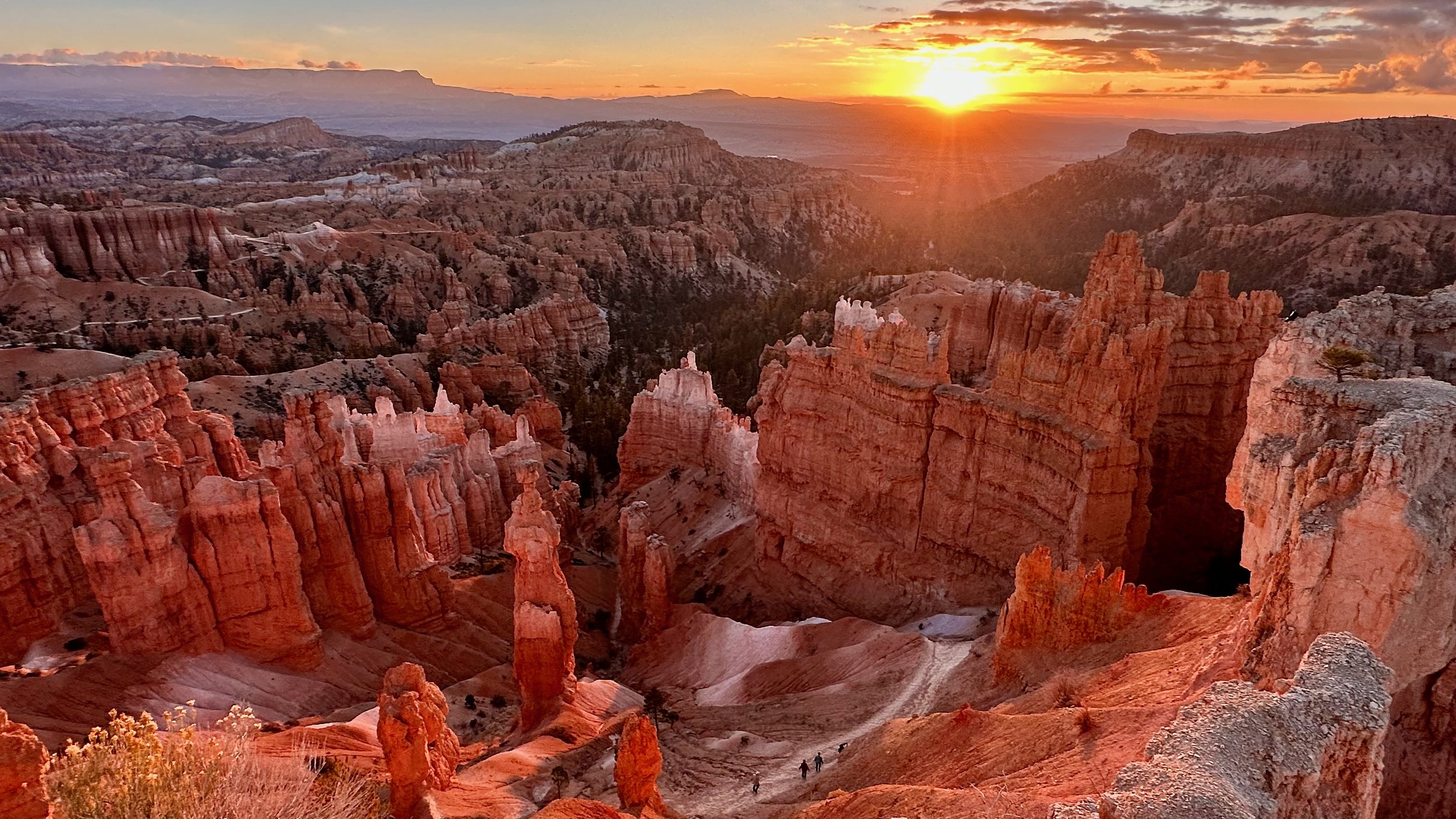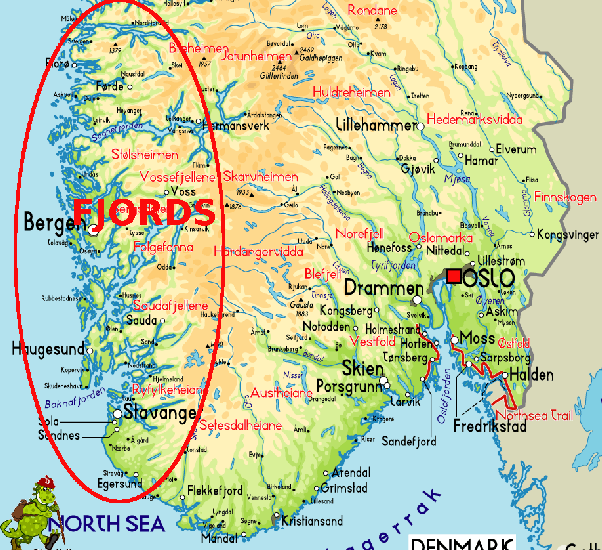Please see my comments on the Tolbachik Volcano Circuit page. After our incredible adventure in the Kluchewskaya Cluster National Park, we drove for 11 hours back to Petropawlowsk or rather to nearby Paratunka, a spot full of hot springs!
Our next objective was the Mutonvsky Volcanic Plateau and its two active volcanoes: Mutnowsky and Gorely. We needed good weather and we were lucky again. We had sunny weather during crucial days and then the rain returned. We hiked out in a cold wind and rain.
This area is quite different from the Tolbachik Circuit. The volcanoes are not as steep and majestic but they have incredible craters with lakes and active vents. The Mutnovsky crater is almost unbelievable. It felt like walking into another world through a narrow gap in the rocky crater. I was truly awe struck and could not believe that the place was real.
We felt that it was an incredible experience to see the magnitude of geothermal formations in such a small place. Furthermore, one can wander around without any restrictions and get close to some very spectacular places.
Evgeny’s drone provided us with a completely different perspective and allowed us to see the grandeur from high above without having to rent a helicopter. We left tired but happy to have been able to see such an unbelievable spot.
The Koryaksky Volcano near Petropawlowsk Kamchatsky (PK). It is 3,456m high. It belongs to the Avachinskaya group of Volcanoes. It had a small eruption of ash in 2009 forcing landing aircraft to change course. the upper part has a 35 degree slope and some exposed rocky sections.
The Avachinsky Volcano 2,751m high is the closest volcano to PK and apparently quite easy to ascend.
The closeup of the upper section of the Koryaksky Volcano.
The Vilyuchinsky Volcano 2,173m. It is 1.5 hr away from PK by car on a so-so road. The sign at its base indicated that it required 6 hours for an ascent.
The viewpoint for the Vilyuchinsky Volcano.
The road from PK to The Plateau of the Mutnovsky Volcano. The area of the Mutnovsky Volcano is located about 70km south from PK and is on the edge of the Mutnovsky National Park. The volcanic plateau is 600 to 900m high where cones of active volcanoes tower above the alpine tundra, free of snow only for three months of the year. There are three volcanoes in the area: the active Muntovsky and Gorely and the dormant Vilyuchinsky. The area receives over 15m of snow in winter! The road is not muddy but very rocky and dusty,
We set up our camp at the base of the Gorely Volcano. The hike to the top of the crater takes an hour (850m elevation gain) but the hike around the entire crater takes a few hours.
The dormant Vilyuchinsky Volcano. At the base of the Gorely Volcano you can see the parking for the day-trippers from PK.
The upper section of the Gorely Volcano. The ascent has an easy gradient but it is long in distance.
Photo by Evgeny Androssov. Going up the Gorely Volcano. The high Mutnovsky Plateau is beyond. You can even see the Pacific Ocean in the distance.
Almost at the top! The Gorely Volcano is located in a large caldera 13 x 12 km in size. The Volcano has 11 craters! The craters are strung one after another. The variety of craters and ease of access make this volcano one of the most spectacular in Kamchatka.
The main crater with a beautiful lake inside. The Gorely Volcano had 9 explosive eruptions in the past. Next to this lake crater is the eruptive crater with an active gas vent. The top of the mountain is the prominent fin in the distance.
drone photo by Evgeny Androssov
The active crater of the Gorely Volcano with the active gas vent on the lower right side. The gas vent has a temperature of 900C. The activity began in 2010 and is still ongoing. The drone photo by Evgeny Androssov.
One of the main craters of the Gorely Volcano seen from the drone. Photo by Evgeny Androssov.
The edge of the crater and the beautiful volcanic lake. Photo by Evgeny Androssov.
The path around the crater is very spectacular. It is like a walkway in the sky!
Fantastic formations of the main crater.
The edge of the main crater.
The entire main crater of the volcano is quite large and requires a few hours to traverse. It is a great hike though providing views of various craters, the surrounding plateau, and distant volcanoes.
The path around the Gorely craters.
The bulky Mutnovsky Volcano towering over the plateau.
The Mutnovsky Volcano seen from the top of the Gorely Volcano. To access the active crater of the Mutnovsky, we walked through the canyon break in the crater wall. The existence of a glacier inside an active volcano was quite incredible.
The top of the Gorely Volcano is 2000m high.
The view from the top of Gorely.
The elevation of the highest point on the Gorely Volcano.
One of the active areas and the steaming ground.
The active main crater of the Gorely Volcano.
The view from the top of Gorely to the Mutnowsky Volcanic Plateau.
Walking on the rim of the Gorely crater with the Opala Volcano in the distance (2,475m).
This side of the mountain was quite hot. Even on this warm day, the steam was visible (and smell-able).
An unnamed crater of the Gorely Volcano and Mutnowski Volcano behind.
On the edge of the Gorely crater with Mutnovsky in the distance.
The active crater of Gorely, We walked by numerous active vents and the smell of sulfur was in the air.
The closeup of one of the vents of the Gorely Volcano.
One can take a day trip to the Gorely crater from PK for around $700 US per person. The large Mi8 helicopter takes about 24 passengers. It has max cruising speed of 225km/h and a flight range of 900km. It is the most popular twin engine helicopter in the world. We observed their approach and landing. On the next photo, see the helicopter parked in front of the crater for scale!
The Mi8 helicopter parked at the rim of the active crater on Gorely Volcano.
The Mutnovsky Volcano 2,323m is 15km away.
The Gorely Volcano from our camp.
Walking through the remains of the 15m snow drifts!
The bears and us shared the path. Thankfully not at the same time!
The bulky Gorely in the distance.
Approaching the Mutnovsky Volcano, still 4km away. We camped here and hiked to the crater without our heavy packs.
The Mutnovsky Volcano has a complex structure. It is really formed from four separate stratovolcanoes with a common top and a double crater of 2 x 1.5km in size. The Vulkannaya River broke through the wall of the crater creating a gorge and provided an access point to the inner crater.
The campsite for the Muntovsky Volcano.
The gap in the crater walls formed by the Vulkannaya River. The trail goes along the crater walls. It feels like walking into a castle!
The gorge of the Vulcannaya River. There is a wonderful waterfall further down.
Day-trippers from PK. It is a full day excursion with a long and shaky drive on both ends of the trip.
The local operators use these monster trucks to negotiate the rough road from PK to Mutnovsky. There seems to be a monster truck cult in PK as some of them were incredibly large.
The general map of the Mutnovsky crater, Aside from this warning, there are no restrictions or barriers preventing a thorough exploration the crater. I am sure that in time, as the number of visitors grow, there will be walkways and barriers (like the Yellowstone NP). It is good to be here before it happens!
Walking into the crater.
As we got closer, it felt unreal to be here! It was hard to imagine that a place like this exists and that we can explore it freely.
Massive walls of the crater. It felt like we were inside a castle from the Lord of the Rings.
A big glacier lies inside the crater stopping at two vast fumarole fields: Donnoye and Verkhneye. An active funnel over these fields emits powerful gas and steam jets, which rise up to 1.5km above the volcano.
The pano view of the fumarole fields.
Inside the active fumarole field.
The pano view of the active fumarole field inside the crater. The filed is full of gas vents, boiling mud, small geysers and other active formations.
Beautiful pool close to the active vents.
The “Boiling River” Vulkannaya. There were some boiling water pools next to the river.
Fumaroles rich in sulfurous gas create various domes of brimstone. I inhaled the gas accidentally and could not breathe as long as I was near it!
Brimstone formations - loud and smelly
Another brimstone dome emitting steam with a jet-like force.
Brimstone
The edge of one of the two active craters.
Two active craters are visible.
This is also an active crater. The much larger lake disappeared after 2003.
The glacier and the edge of the fumarole filed.
The active crater of the Mutnovsky Volcano.
At the bottom of the 150 deep crater, there is a red lake.
The red lake of the active crater.
A large cloud of gas emanating from the active crater.
The active crater of the Mutnovsky. Notice the people in the gap. Drone photo by Evgeny Androssov
The active crater of the Mutnovsky and the fumarole field. drone photo by Evgeny Androssov
The small green lake is also the bottom of an active crater. Drone photo by Evgeny Androssov
The 150m deep active crater of the Muntovsky. Drone photo by Evgeny Androssov
The double crater of the Muntovsky with two colored lakes! Drone photo by Evgeny Adnrossov
The large glacier and the fumarole field of the Muntovsky Volcano from the drone. Photo by Evgeny Androssov.
The fumarole fields of the Mutnovsky from the drone. Photo by Evgeny Androssov.
Hiking back! We leave the interesting Mutnovsky Volcano behind.
The north side of the Mutnovsky Volcano. We were lucky with the weather again. Low cloud and rain moved in as we left the area.
Hiking from the Mutnovsky Volcano to the Mutnovskaya Geothermal Station.
The Mutnovskaya Geothermal Station in the distance. The power plant uses the geothermal heat to produce electricity. The gas reserves provide power to the station. Numerous wells channeling hot steam to the station dot the landscape. The plant can withstand an earthquake up to magnitude 9!
The Mutnovka Electric Station. It produces 30% of all electricity in Kamchatka. The deepest well drilled for the purpose of extracting steam is 2.2km.
Old part of the station
One of the 90 wells of the station.
The Dachnye Hot Springs. There are numerous boiling and pulsating springs, fumaroles the temperature of which can reach up to 250C.
Nature’s steam room
This wonderful campsite has hot springs nearby.
Some of the more exotic souvenirs in PK.
PK souvenirs…













